“Welcome to 1816.” Magdelaine La Framboise’s spirit greeted our arrival to the island she had loved. The Odawa-French fur trader, who had fascinated me for years, invited my husband, Bob, and me to stay at the Harbour View Inn. In its prior life, the current B&B had been her home. Its construction was overseen by her son-in-law, Captain Benjamin Pierce, brother to future President Franklin Pierce. The gentle breezes whispered Magdelaine's words, “I apologize that I can’t spend more time with you. The Harbor is buzzing, so you won’t lack for company. I must paddle my son, Joseph, to Montreal for school, and I’m waist deep in plans for my daughter Josette’s wedding. It’s the social event of our busy summer. Please make yourselves at home. Enjoy your stay.”
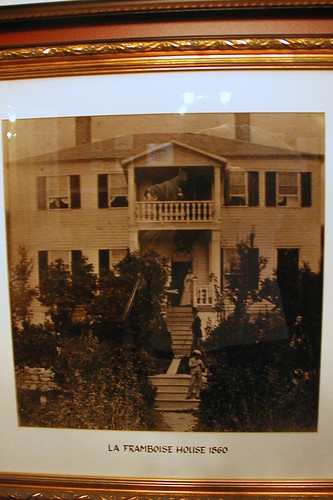
For three glorious summer days, Bob and I hiked and biked the island that was the center of the Great Lakes fur trade when the luxuriant beaver pelt reigned king. Our choice of this weekend destination came not by chance, but after careful calculation. We wanted to recharge, but we also wanted to take home more than breathtaking mental snapshots and a pile of dirty laundry. I harbored an additional motive. I was writing a novel about the indomitable Madame La Framboise, a trader and the grand matriarch of Mackinac Island. When I voiced my suggestion, Bob said, “Let’s get packing.” I would have an opportunity to walk where Magdelaine had walked, see what she had seen, and feel what her home had been like.

A small duffle bag each was sufficient for blue jeans, t-shirts, and a light jacket which would serve double duty: warmth if a chilly east wind blew and a way to dress up jeans for casual dinners. We wore good walking shoes.
We turned off computers, tucked cell phones in a cupboard drawer, and drove to Mackinaw City, where a catamaran sped us to Haldimand Bay. For fifteen short minutes we savored striking views of the Straits of Mackinac where Lake Huron and Lake Michigan kissed. There was no additional charge for the sprinkling of magic that surrounded us when we stepped ashore and found ourselves two centuries back in time at the place traders like Magdelaine had guided their fur-filled birch bark canoes to the summer gathering known as Rendezvous.
Our illusion of reversing time was nurtured by the island’s prohibition against automobiles. A horse-drawn wagon met us at the harbor. The driver grabbed our bags and would deliver them to our room.
A half-block walk and we stood where Father Jacques Marquette built his humble mission on the enchanted island that the Ojibwe and Odawa called the birthplace of the world, a sacred spot where tribes gathered for council meetings and fairies danced. The First People called the island Mi-shi-ne-macki-naw-go, the great turtle. The name was spelled at least fifty-five different ways as it evolved to Mackinac Island. I imagined passing English soldiers, French fur traders, Native American hunters and trappers, and a smattering of merchants as we walked Main Street.
Bob and I charted our strategy as we relaxed at the Ice House Bar and Grill with cold beers and fresh-cut potato chips served with a Blue Cheese Fondue and Caramelized Onion Dip that tingled our taste buds.
In early afternoon, we ambled along interior roads through the center of the island to Fort Holmes, built by the English when they defeated the Americans in 1814.

At Point Lookout, we reveled in the spectacle of Lake Huron as the bright sunshine created a diamond-studded overlay on the sapphire waters. In a world that had changed rapidly since 1800, the Great Lake remained a constant that yielded neither to man nor nature. We admired the seventy-five-foot limestone breccia rock mass called Sugar Loaf. In my novel, it would be a perfect place for Magdelaine and her granddaughter, Harriet, to picnic.
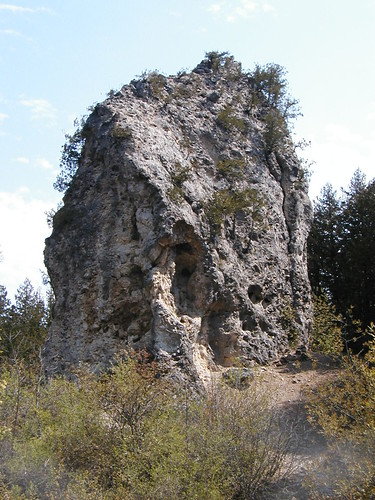
We investigated Skull Cave, a tribal burial ground. During an attack on mainland Fort Michilimackinac in 1763, Alexander Henry was hidden there by his Ojibwe friend, Wawatum. The kindness saved the Englishman’s life.
As the sun descended on our first day, we headed to Millie’s on Main. Food had changed with passing time. There was no pemmican or sagamité on the menu, though I would have liked to try both. I ordered pan-fried Michigan perch and Bob chose the Yooper Beef Pastie. We saved room to share a bread pudding with bourbon sauce. Pure decadence, but this qualified as a vacation, even if it was a working one. Our server delivered this other-worldly dessert with a grin and a warning, “Customers sometimes forget their manners and lick the plates.”
After dinner, the smell of fudge wafted from small shops and tempted us to purchase a sweet indulgence for later. Flickering fireflies guided us past elegant Victorians to the Harbour View Inn, where I had requested the room believed to have been Magdelaine La Framboise’s bedroom when the inn was her private residence. I hoped to channel her spirit, or at least feel closer to her, as I contemplated the biography I had committed to write about her life. That night I wandered about the inn. I studied every photograph hung on the walls, ran my fingers over the raw wood boards that remained from Magdelaine’s original cottage. This inn, when it became her lavish home, was erected around the shell of the original cabin that Joseph, Magdelaine’s husband, had built for them on the island after they married in 1794.
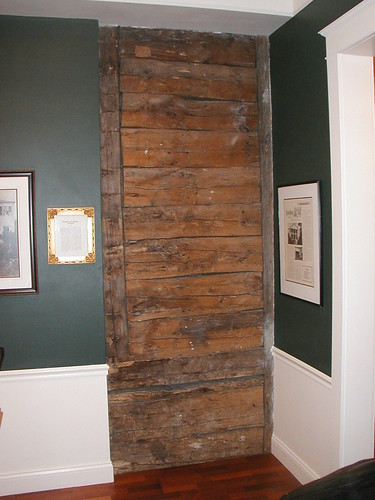
A piece of the original cabin Joseph built
I made myself comfortable on the parlor sofa, looked out at the harbor and reflected on the wedding of Betsy Fisher, Magdelaine’s grandniece. Betsy’s vows were exchanged just inches from where I sat. I could almost smell the pork roast cooking in the kitchen to feed the hungry guests after the ceremony. Betsy had been fourteen years old. Less than a month after the wedding, she and her bridegroom, Henry Baird, had set sail aboard the schooner Jackson for their new home in the Wisconsin Territory. Henry would be the first and only lawyer in Green Bay.
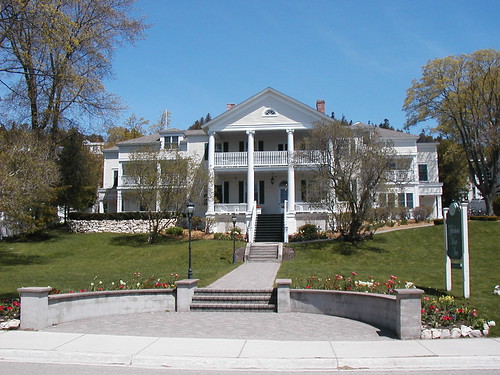
Thinking back, I remembered little about my own life when I was fourteen, but I know for certain I was more interested in talking on the phone and pleading with my mother to extend my curfew than traipsing into the wilderness to set up housekeeping.
When the proprietor of the Harbour View Inn wasn’t looking, I sneaked a peak behind the closed door at the top of the stairs, saw attic rafters, and wondered if this was where Reverend William Ferry had boarded his students when they resided with Magdelaine. At the bottom of that same flight of stairs, I sneaked a second peak, this time behind a door that led to the cellar. Reverend Ferry had noted in his journals that he was allowed to use as much of the root cellar as he wished. It was included in his one-hundred-dollar-a-year rent.
Saturday Bob and I set off to explore Fort Mackinac, where history and dazzling scenery walked like lovers, hand in hand. The fort, built by the British to control the strategic Straits of Mackinac during the American Revolutionary War, perched on a steep limestone cliff above Lake Huron’s vast expanse. It was in a small room at this fort that Josette, Magdelaine’s only daughter, died in childbirth. She was attended by Dr. William Beaumont, who at the time was the army physician stationed at the fort. Beaumont later became known as the Father of Gastric Physiology. Magdelaine’s first grandson, Benjamin, just days after his birth, followed his mother into death.
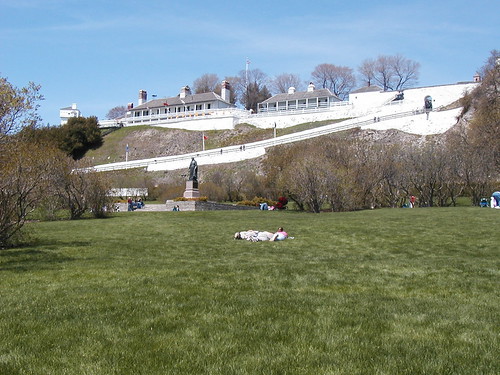
Bob and I found ourselves surrounded by costumed soldiers assembled for roll call. They practiced military drills on the parade grounds, carried out reenactments of marches, performed a cannon salute over the harbor and offered weapons demonstrations. Interpretive displays and period-costumed guides dropped us in the middle of the action. I pictured Captain Benjamin Pierce calling his men to attention.
During lunch at the Fort Tea House, we barely tasted our salads. The scenic panorama that played out before us distracted our attention from food. Our visual senses were stimulated by freighters passing on the horizon. The bustle of the village below, where the frenetic activity mesmerized us could have as easily been the early 1800s as the twenty-first century.
Our tickets to Fort Mackinac provided entrance to several historic buildings along Market Street. After lunch we sauntered from the McGulpin House and Beaumont Memorial at the east end to the Benjamin Blacksmith Shop and the Biddle House at the west end. I wondered how many times Agathe Biddle and Magdelaine had sat at the kitchen table drinking English tea and discussing their children.
Along the way, we stood on the spot where in the 1820s John Jacob Astor, the country’s first millionaire, established the American Fur Company’s northern headquarters. From that building millions of dollars worth of furs, including those Magdelaine and her engagés collected during the wintering seasons, were sorted, baled, and shipped to the East Coast and Europe.
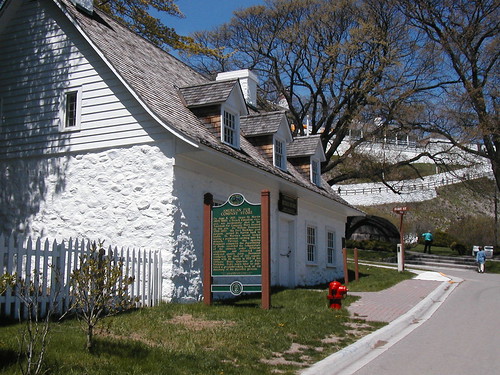
American Fur Company Store on Mackinac Island
On our way back to our B & B, we stopped at Ste. Anne’s Catholic Church. Magdelaine’s tomb stands in the basement. We solemnly stood and paid our respects. A tiny treasure trove of a museum surrounds her final resting place. We studied exhibits, learned details about Magdelaine’s life, the fur trade, the Catholic missionaries in the Great Lakes, and the birth and growth of Ste. Anne’s. The generous people at the church patiently answered my questions and let me review the plot map for the island’s Catholic Cemetery.
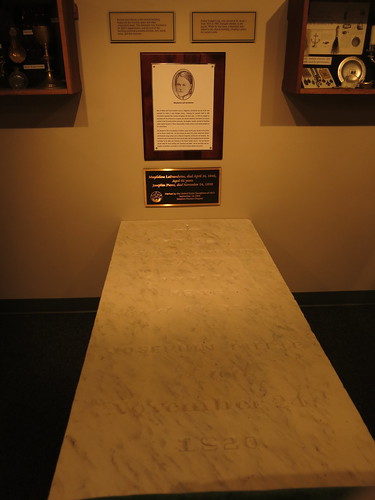
After freshening up, we were ready to walk back to the village. Saturday night’s dinner was planked whitefish at the Village Inn. Caught that morning, the fish provided a gastronomic treat that made our mouths wish our stomachs hadn’t filled so fast. It was easy to understand why the Native Americans called Mackinac “the place of the fish.”
Before saying goodbye on Sunday, we visited the Catholic Cemetery and searched for the graves of Magdelaine’s sister, Therese Schindler, and their close friend, Agathe Biddle. We then hiked the 8.3 mile island perimeter on M-185, the only Michigan highway that bans motorized vehicles. Toward the end of our journey, Madame LaFramboise’s apparition again drifted close to bid us farewell. “I saved Arch Rock for last so its beauty will travel fresh in your mind,” she said. “It was carved by the tears of She-who-walks-like-the-mist when her father tied her to the rock to separate her from her lover.”
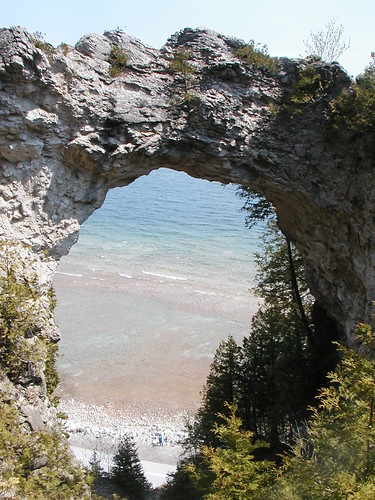
Arch Rock
Magdelaine smiled as I packed my notebooks and camera into my bag. She had tied our hearts to Mackinac Island’s rich history, and made us promise to return.
Information for Travelers to Mackinac Island
• Mackinac Island was the second National Park established (Yellowstone was first). It is currently a State Park and National Historic Site.
• Mackinac Island Tourism Bureau: 906.847.3783 or 800.454.5227, 7274 Main Street, Mackinac Island, across from Marquette Park, open May to Mid-October. Make this your first stop after arrival. It’s the place to pick up maps and obtain valuable information about what is happening on the island.
• Harbour View Inn: harbourviewinn.com, 906.847.0101, 6860 Main Street, Mackinac Island.
• Ice House Bar and Grill: theislandhouse.com/ice-house-bar-and-grill, 906.847.3347, 6966 Main Street, Mackinac Island.
• Millie’s On Main: 906.847.9901, 7294 Main Street, Mackinac Island.
• Village Inn Restaurant: www.villageinn.com, 906.847.3542, 495 Hoban Street, Mackinac Island.
• Ferries:
Star Line Ferry: 800.638.9892, 801 South Huron Avenue, Mackinaw City, MI.
Shepler’s Mackinac Island Ferry: sheplersferry.com, 800.828.6157, 556 East Central Avenue, Mackinaw City, MI
• My travel tips for Mackinac Island: Michigan's Small Town Treasures: Mackinac Island
Click the photo to order Ardent Spirit from Barnes & Noble:
J. K. Royce, who has written a fictionalized biography about Magdelaine La Framboise, tells about her research trip and vacation to the beautiful Mackinac Island. Ms. Royce published the novel, Ardent Spirit, in April, 2017 and it is available in paperback or hard cover.
All photos courtesy and copyright J.K. Royce

